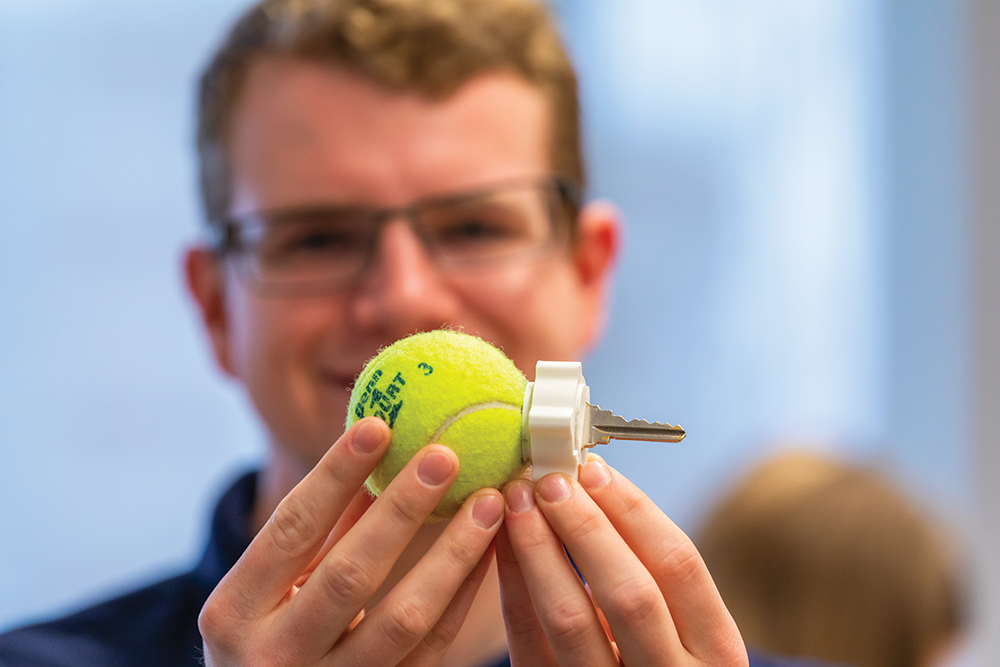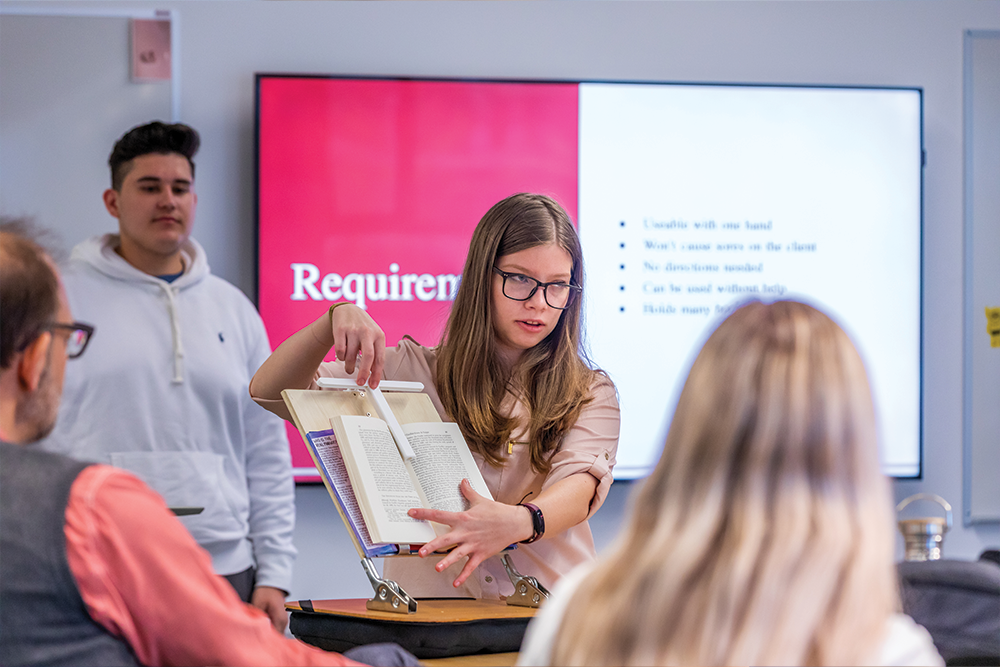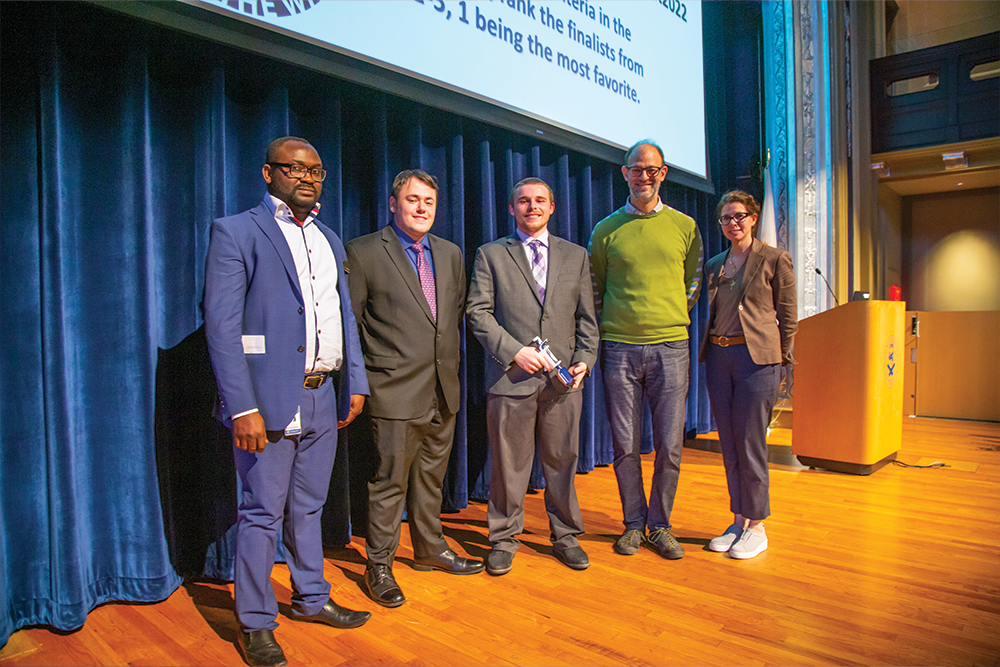In JWU’s Product Design program, students use art to understand the world and science to explain it
A FOOT-PEDAL SYSTEM for using laboratory pipettes. A lamp made out of the roots of mushrooms. A house that moves on dozens of little legs, like a giant rectangular centipede. What do these disparate and perhaps outlandishseeming ideas have in common? They all come from the creative minds of Johnson & Wales students in the Product Design program, and they’re all, in one way or another, sustainable.
“All sustainability means is fulfilling an objective over a long period of time,” says Walter Zesk, a computational designer and associate professor who, along with Associate Professor Jonathan Harris, teaches almost all the classes in the new major. “So that objective might be producing healthy food. It might be helping people enjoy personal freedoms or preserve their jobs or their mental health. It might be about making cities happier places by planting more trees, because studies correlate violence with a lack of green space. Well-being, happiness and health are all goals that should be sustained.”
But wait, isn’t sustainability all about protecting the environment? “That’s part of it,” Zesk says. “But to me it has nothing to do with loving trees or loving whales or being green for its own sake, and everything to do with designing products that will make life better for people.”
Whales are lovable, Zesk concedes, but he says that often the implication is that helping the environment comes at the expense of helping people, when in reality, “sustainability is fundamentally selfish. If we trash the world, the world’s not going to disappear. Animals and trees will still be here. It’s just us that will be gone. I think people are finally starting to realize that.”
It’s not just attitudes that have changed in the past quarter century. In the late ’90s, JWU started offering a two-year degree in Computer Aided Drafting (CAD) software, later adding project management and some other skills to create the CAD-based four-year Engineering Design and Configuration Management major. But a decade and a half into the 21st century, the program was starting to look tired. Most architects and engineers no longer hand their ideas over to CAD operators who develop diagrams, blueprints and technical drawings digitally, says Harris. “Rather than CAD operators,” he says, “we now need thinkers who can use CAD. As a university we had to start teaching students to understand products, culture, human factors and human needs, and to use technology to serve people instead of technology being the end goal.”

ABOVE: A design solution to ease using keys
So a few years ago, Harris, Zesk and Design Department Chair Deana Marzocchi, with the help of a former Rhode Island School of Design (RISD) dean and a private-sector CEO, revamped the existing program. It still includes some technical skills, like learning the 3D CADbased software Rhino, but it has a much broader mandate, more in the STEAM — science, technology engineering, arts, and math — category than STEM. “What we do is bordering technology and art,” Harris says, noting that both he and Zesk come from humanities backgrounds. “I have a master’s in industrial design from RISD, but also a bachelor’s degree in comparative literature from the University of Wisconsin. Walter’s got a bunch of degrees, including one in art and philosophy from Wesleyan. You need art to understand the world; science just helps you explain it.”
Even though you won’t find the word “sustainability” in the course catalog, it is an integral part of the program. “We don’t teach sustainability per se because it can’t be separated from product design,” says Harris. “It is embedded in every concept we create. Also, the issues we cover are largely studentdriven. We may present them with a problem and ask them to solve it, but they often have an opportunity to develop their own ideas and find problems out in the world that need solving. We have students write their own mission statements when they start, and they all end up choosing issues that are sustainably based.”
Even though you won’t find the word “sustainability” in the course catalog, it is an integral part of the program.ASSOCIATE PROFESSOR, JONATHAN HARRIS
“There’s just a lot more awareness about it nowadays,” says Marzocchi. “There’s so much more waste now. When I was younger, if we went to Faneuil Hall and found a special doll , we would cherish it. Now there’s just all this junk — dollar stores, plastic shopping bags. I think the overload is starting to get to people.” The pandemic, she says, seems to have increased the awareness of consumerism, climate change and related topics even more. “People saw smog clearing up when there were no cars on the road, and working from home made a lot of people realize they could cut back and survive without rushing around and leaving paper coffee cups behind everywhere they went.”
Drop in to Jonathan Harris's User-Centered Design course and you might find a study in controlled chaos, with students gathered around a table here, a workstation there, perhaps even the door to the classroom, testing prototypes of various objects made of cardboard, wire, wood blocks, plexiglass, tape and existing products pressed into service as components, and discussing the pros and cons of each.
“What if you could hold it, like, upside down?” one student asks the “client,” biotechnology research assistant Hannah Tremblay, as she tests various pipette mockups to ease the constant physical effort of her job, made worse by the juvenile rheumatoid arthritis (JRA) she was diagnosed with at 16 years old. “So you’d have this motion and could still have your hand neutral?”
“Yeah, that way you’re not working against gravity,” says another.
“Would an inflatable donut help so you can slide your elbow back and forth more easily?” asks a third.
Harris’s students have broken up into teams to work on three challenges: pipetting measured liquids from point A to point B at work, reading a book and turning the pages with one hand, and opening doors with keys — tasks most people never give a second thought, until JRA or old age or injury causes mechanical impediments or painful inflammation and makes them exponentially harder. Early in the semester, JWU’s occupational therapy (OT) doctoral candidates met with Harris’s class about collaborating on solutions for challenges faced by their clients. After a no-wrong-answers brainstorming session where students sketched their ideas — including over-the-shoulder bookrests, magnetic and adhesive page-flatteners, and hiring a butler (why not!) — on dozens of sticky notes, and field trips that took the future product designers to Tremblay’s lab and the OT department to try out wheelchairs, arm splints and other medical devices that limited their movement, they jury-rigged their primitive prototypes to present for feedback.
“We have one more design, which is my favorite,” Harris chimes in. “Instead of pressing the plunger with your thumb, you control the pipette with a foot pedal attached to a throttle cable hanging over the desk from the floor.” Their drawings are met with enthusiasm from Tremblay and the OT group.
“That would be so cool,” Tremblay says. “I never use my feet all day, and it would obviously be a lot easier than having to keep my grip up all the time.”
“Sustainability absolutely matters to this sort of thing,” says OT student Kelsey Gately ’23. “Not only in terms of the client being able to work in her desired field, but because if we make products better from the beginning, we won’t have to put more stuff out into the world down the road in terms of modifications. Universal design makes products that can be used by everyone, no matter what size they are or if they have different capabilities.” Tremblay’s JRA makes her job more difficult, but pipetter’s thumb is a repetitive-strain condition many scientists develop. The foot-pedal design turned out to be so popular and ingenious it was entered into this year’s Sharkfest, a universitywide competition modeled on the TV show “Shark Tank,” and it won second place. The award granted its creators, Michael Dattolo ’24 and Mathew Hartung ’26, a $2,500 prize and made them eligible for coaching, mentoring and assistance with business plans should they decide to go forward in marketing the device.
Most of the products designed in Harris and Zesk’s classes will never make it to market, but many are born of wildly imaginative solutions to sometimes theoretical, sometimes experiential problems. The moving house, for example, was junior Henry Drapeau’s suggestion for an assignment in Zesk’s Computational Design class, in which students were asked to create a shelter for a particular kind of environment of their own choosing. The house, powered by the kinetic energy of its residents walking around inside, would keep grassy plains from being destroyed by development. Other ideas for that class included junior Zak Vallee’s pod-style home that could be used on the surface of Mars; junior Brian Bleakney’s “waterworld” shelters, to be used if climate change floods all the land; and junior Jonah McGowan’s individual shelter for displaced persons in desert regions, which would collect water created by its user’s breath at night but is light enough to be carried like a backpack.
The mycelium lamp was for a course Zesk taught during the pandemic, when studio classes were a challenge since everything was remote, but mycelium kits were available online. For a materials class taught by adjunct Karen Labont, Keely Doyle ’24 suggested using algae in place of plastics. But such products are always only part of a bigger picture that has to be considered.
“The systems part of product design is understanding where in the system you can affect something,” says Harris. “What decisions can a designer make to change the amount of plastic we use? We can talk to friends about it, burn down the plastics factory or create a new system where if consumers buy something that’s plastic they can bring it back to you to refill it after they use up the product itself.”
Systems mean products aren’t used in a vacuum, Zesk points out, and more and more products are being designed that are incorporated into systems that include software interfaces. “If I redesigned a book,” says Chris Dimovski ’24 by way of explanation, “the growth factor is not really there. It can’t be made significantly different from how it is. But robotics and other technologies are going to blow up and keep getting bigger and bigger.”
Zesk, Harris and Marzocchi would like to see their program get bigger too, maxing out at about 15 students per class, or three times the class size that’s typical now. “The quality goes up if you go from four to 12 students, for example, because you have more perspectives,” says Zesk. “But more than that and you can’t give everyone the time they need. We would like to eventually start adding classes and faculty, though.”
Marzocchi agrees and says she’s considering emphasizing sustainability more in marketing materials and course requirements. “Students have a mindset for it, for sure,” she says. “It should be something explicit in our outcomes. Ethics are in our outcomes, and when you think about ethical considerations, sustainability needs to be enveloped in that.”
Plus, she maintains, having a strong background in the issue can’t hurt when the students go out into the “real” world. “Unfortunately, there are still a lot of companies out there that don’t care and re merely concerned with making a lot of stuff as cheaply as possible,” says Drapeau. “But luckily, it’s becoming required more and more for companies to be interested in sustainability, or at least look like they are, because it helps them make sales. So regardless of the reason, I think it’s at the forefront these days.” He says he’ll be looking for employers who consider it part of their mandate.
But the big question is, will employers be looking for students who consider sustainability an imperative? “I definitely hope so!” says McGowan. JWU

